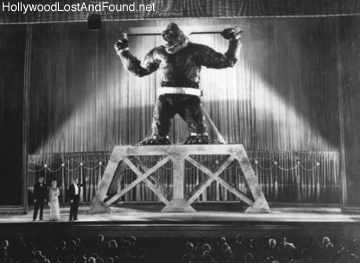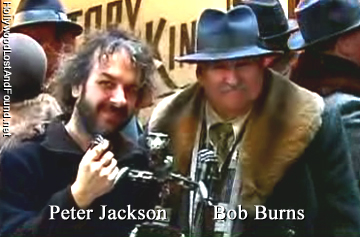Hollywood Lost and Found
Props and Artifacts
The Original
"King Kong"
Armature
The original RKO production of "King Kong" (1933), directed by Merian C. Cooper and Ernest B. Schoedsack, made innovative use of many special effects techniques available at the time. The most important process to the film was stop motion animation, which brought Kong himself to life.
Stop motion animation is a process where models and other objects are photographed one frame at a time, with very small but carefully planned moves between frames. When shown together at the proper speed, "persistence of vision" creates the illusion of life.
For "King Kong," special effects wizard Willis O’Brien and sculptor Marcel Delgado created two 18-inch-high full-body miniatures of the giant ape. They began by making extremely durable articulated metal armatures, which were covered with sponge rubber for the ape’s muscle structure, and rabbit fur for his hair. "I was given pruned rabbit fur to cover him, and I was never satisfied with that because I knew it would show the fingerprints of the animators," Delgado said – which was indeed the case.
Delgado sculpted the faces for the two Kong figures in latex rubber, and the heads on each of them were slightly different. One had a longer face, and was used in the Skull Island sequences where Kong attacks the explorers on the log bridge, and when he wrestles the Tyrannosaurus Rex. The other figure had a rounder head, and is seen in the rest of the Skull Island scenes, and all the New York sequences.
The first Kong figure with the longer face was created for test sequences that helped sell the idea of the movie to RKO executives. To save production costs, the footage was incorporated into the actual film. But it is believed that Marian C. Cooper thought its long face seemed too human – and had Marcel Delgado sculpt the rounder face, which was used to finish the work on the film.
The second of the two Kong figures was later cannibalized for parts in other creations. The other armature survived because it was used again in "Son of Kong" (1933), which went into production soon after the first film was released.
Evidently the figure stayed at RKO until 1962. Jim Danforth, an animator working on "Jack the Giant Killer" in production that same year, remembers borrowing two fingers from Kong’s left hand – desperately needing the parts for the armature of the two-headed monster in the film. Soon after, animator Phil Kellison rescued the Kong model from the studio. After discovering that the remaining rubber skin was beginning to eat away at the figure’s metal hardware, he had Kong steam-cleaned to its present state – the original bare metal skeleton. Film historian and collector Bob Burns, a friend of Kellison, said that when the person was told what he was cleaning, he began exclaiming "I’m killing King Kong! I’m killing King Kong!"
 The Kong skeleton was displayed for a time at Movie World, a museum in Buena Park, California, which had borrowed the armature from Kellison in the early 1970’s. But when Movie World went out of business, King Kong seemed to be lost in the shuffle. Bob Burns, concerned for the famous prop, kept pestering Phil to follow up on it – but the former owner of the museum seemed to just give them the run-around. The Kong skeleton was displayed for a time at Movie World, a museum in Buena Park, California, which had borrowed the armature from Kellison in the early 1970’s. But when Movie World went out of business, King Kong seemed to be lost in the shuffle. Bob Burns, concerned for the famous prop, kept pestering Phil to follow up on it – but the former owner of the museum seemed to just give them the run-around.
In 1975, Bob found himself at the place where the artifacts from Movie World were stored, helping his friend Bill Malone take home the original Robby the Robot. To Bob’s surprise, he spotted the King Kong armature in a corner, and immediately contacted Phil. After Kellison picked up the prop, Bob was surprised yet again when Phil gave him the armature for his collection – where it resides to this day.
The Smithsonian Institute has made repeated attempts to borrow or purchase the skeleton from Bob. Fearful of it being lost again, he has refused. Even so, in a very shocking move, the Smithsonian went on to display a different ape figure, falsely claiming it was the King Kong model. Only after Bob appeared on a CBS report correcting the museum’s claim did the Smithsonian amend the piece’s label– but then only to read something to the effect of "this may have been the model."

Although Bob is very protective of the Kong armature, he has loaned it out on several occasions – but only when Bob himself is never far from the piece at the time. In October of 2005, when director Peter Jackson was finishing his remake of "King Kong," he flew Bob Burns, his wife Kathy, and the King Kong skeleton to the location in New Zealand. They spent a week as guests of the production, showing off the historic armature to the crew. The animators even filmed the model for reference (animating it probably for the first time since its use in the "Kong" sequel in 1933). And Bob and Kathy were given cameos in the film, screaming at Kong during the film’s climax.
When Jackson’s King Kong opened in December of 2005, Bob, Kathy, and the original Kong figure were special guests at the film’s New York premiere. Bob handed Kong over to Jackson for the evening, who held the metal skeleton tightly - jokingly referring to it as his "date." The original King Kong sat on his lap during the screening.
The original King Kong armature resides in the private collection of Bob Burns - but Sideshow Collectibles sells authorized replicas, which are perfectly recreated from the original piece.
- Steve Lee
28 December 2005
Sources:
Burns, Bob, and John Michlig. It Came From Bob's Basement! San Francisco: Chronicle Books, 2000.
Goldner, Orville, and George E. Turner. The Making of King Kong. New York: A.S. Barnes, 1975.
Official Bob Burns Website, The. <http://bobburns.mycottage.com>
Sideshow Collectibles. <http://www.SideshowCollectibles.com>
Skull Island. <http://www.SkullIsland.net>
Back to Props
Home / Features / Film Sound / Movie Props / Locations
Trivia / Events / Tributes / Recommendations / Blog / About
Bibliography / Links / FAQs / Shop / Message Board / Disclaimers / Site Map
Please support our site by visiting our affiliates:
|

 The Kong skeleton was displayed for a time at Movie World, a museum in Buena Park, California, which had borrowed the armature from Kellison in the early 1970’s. But when Movie World went out of business, King Kong seemed to be lost in the shuffle. Bob Burns, concerned for the famous prop, kept pestering Phil to follow up on it – but the former owner of the museum seemed to just give them the run-around.
The Kong skeleton was displayed for a time at Movie World, a museum in Buena Park, California, which had borrowed the armature from Kellison in the early 1970’s. But when Movie World went out of business, King Kong seemed to be lost in the shuffle. Bob Burns, concerned for the famous prop, kept pestering Phil to follow up on it – but the former owner of the museum seemed to just give them the run-around.